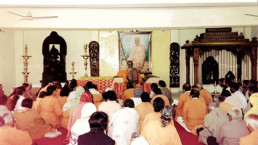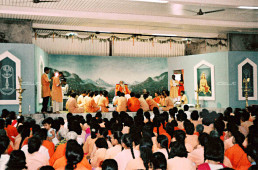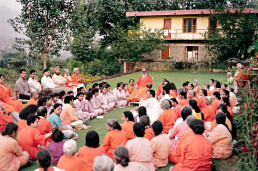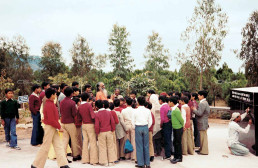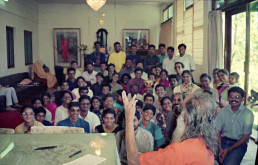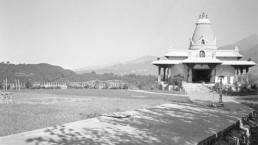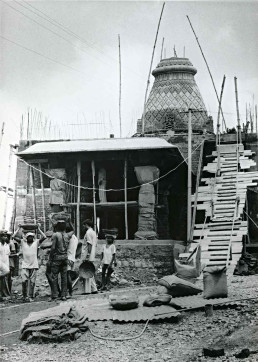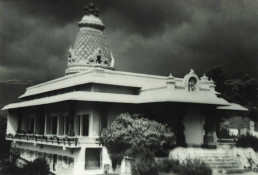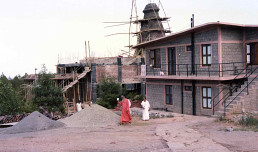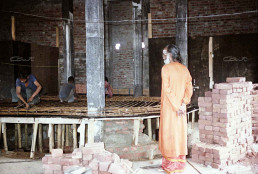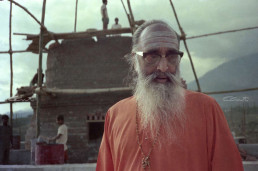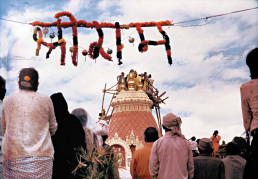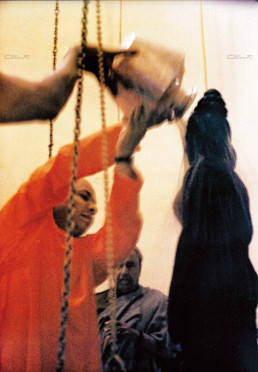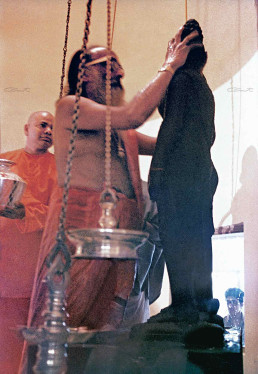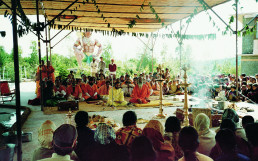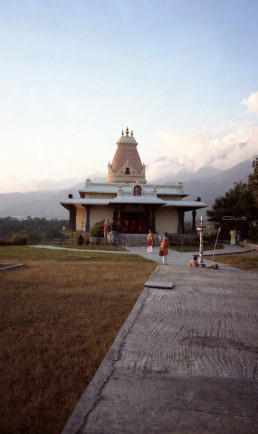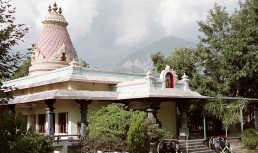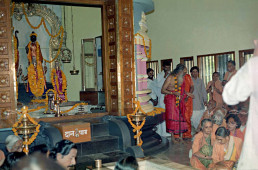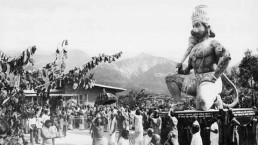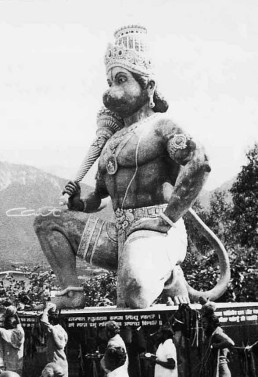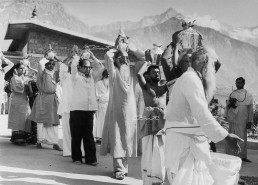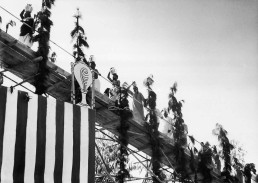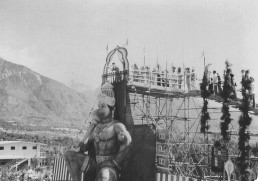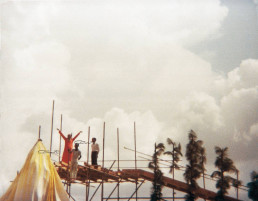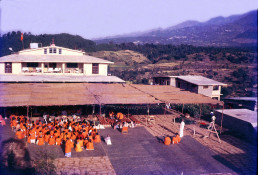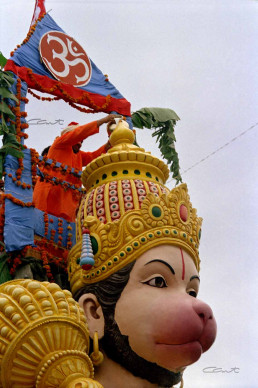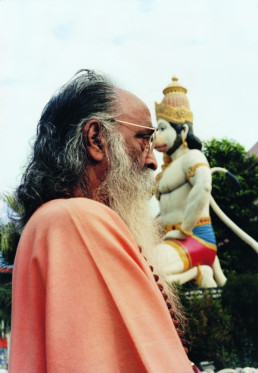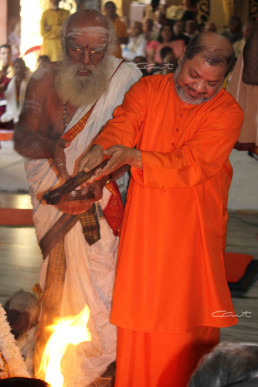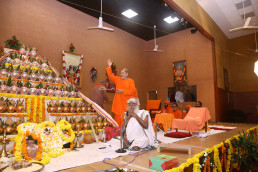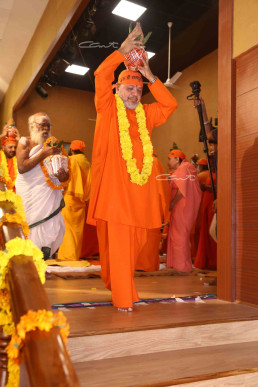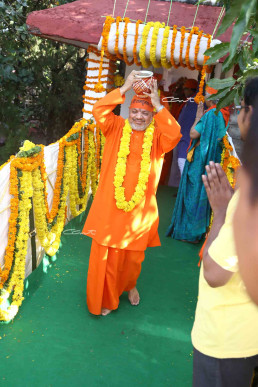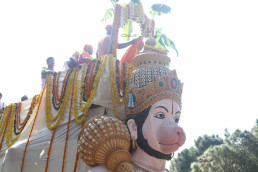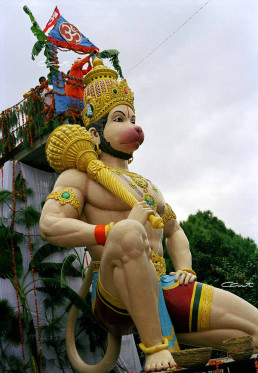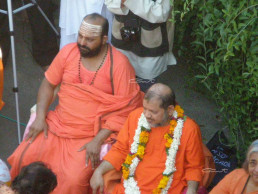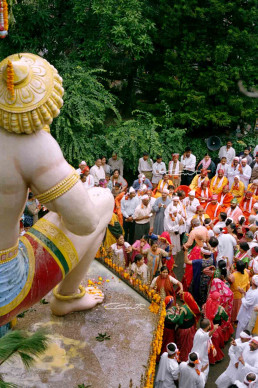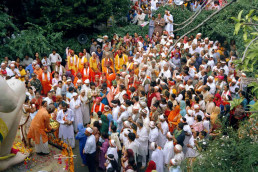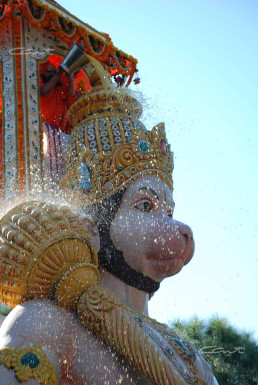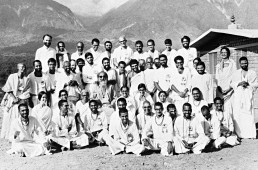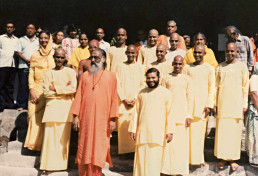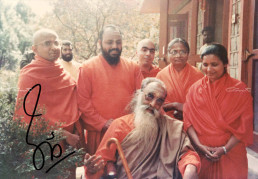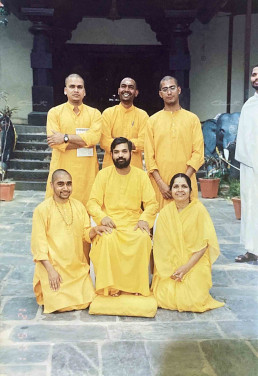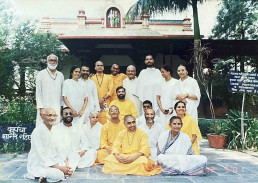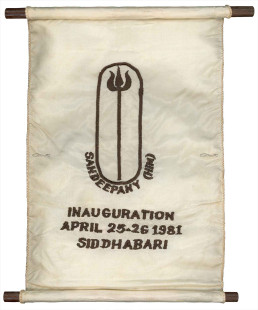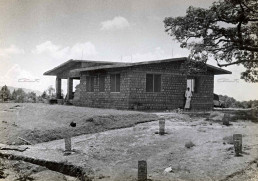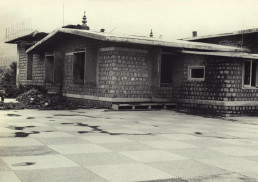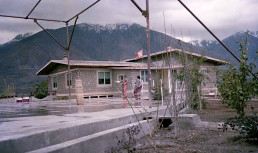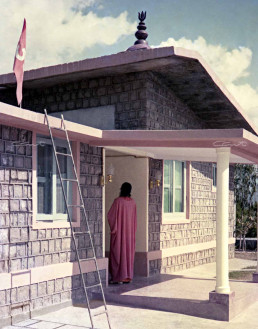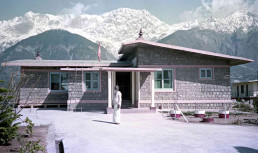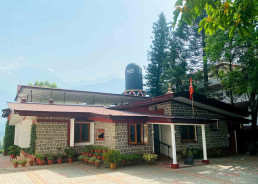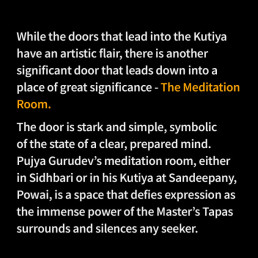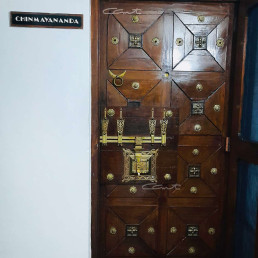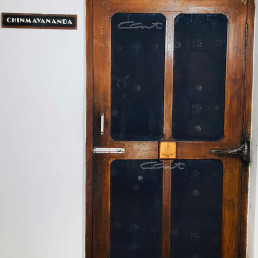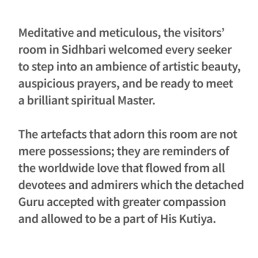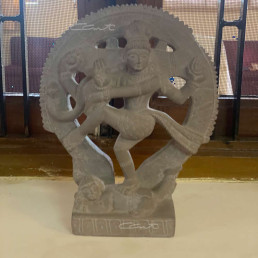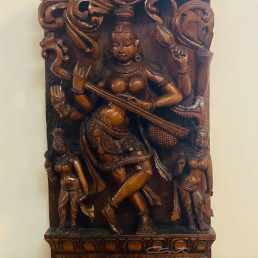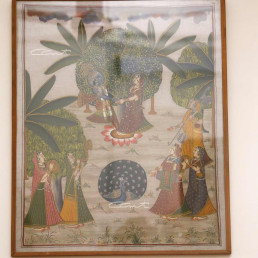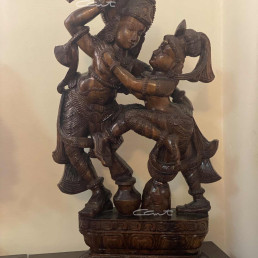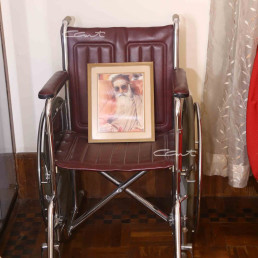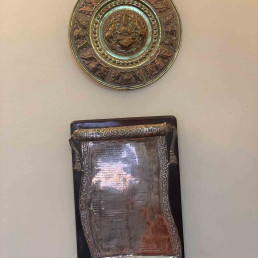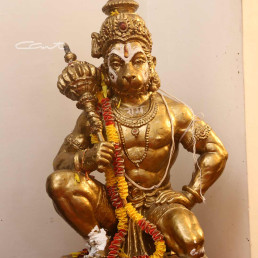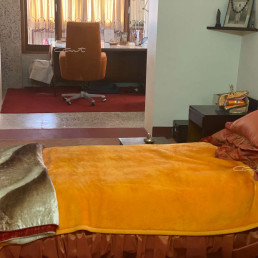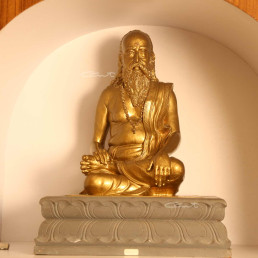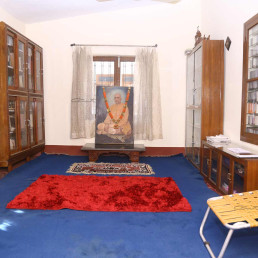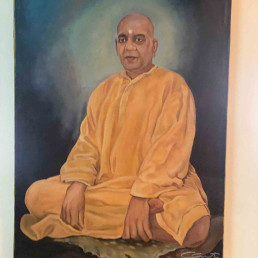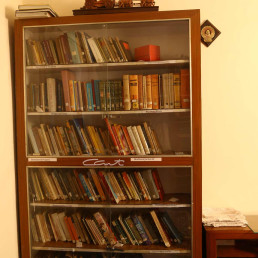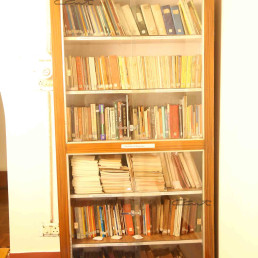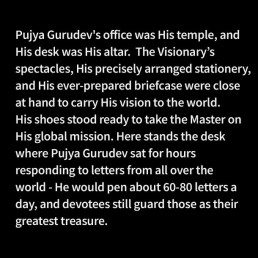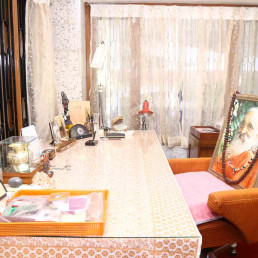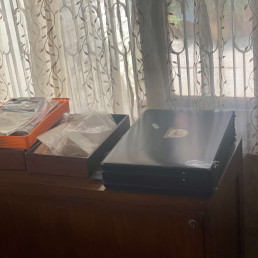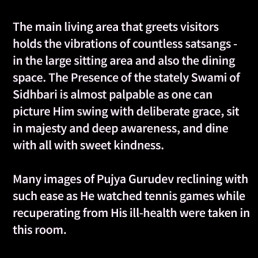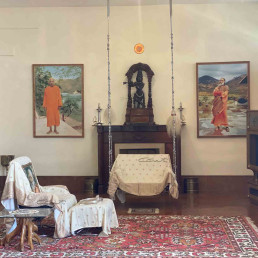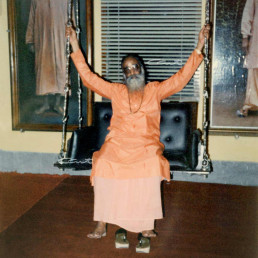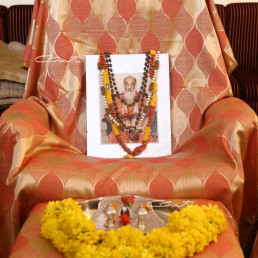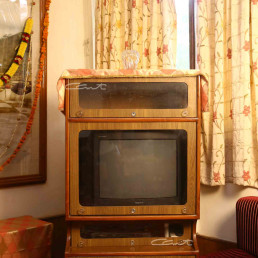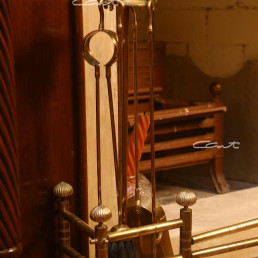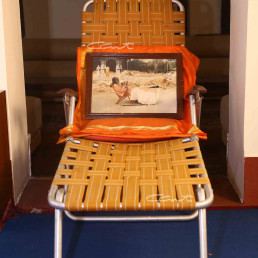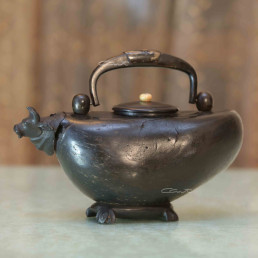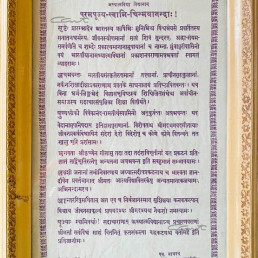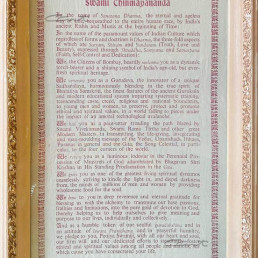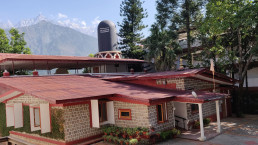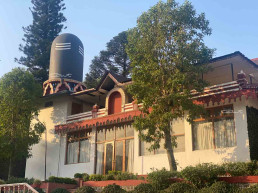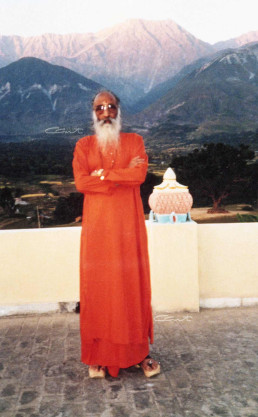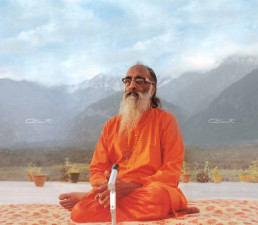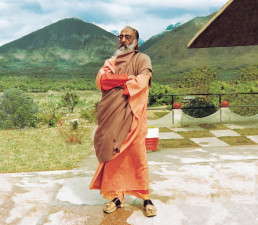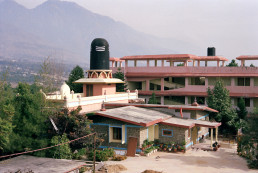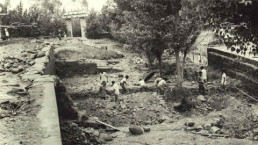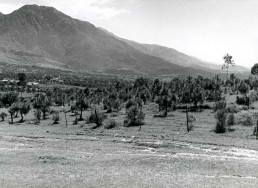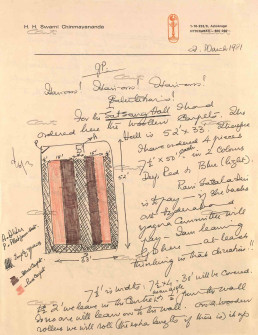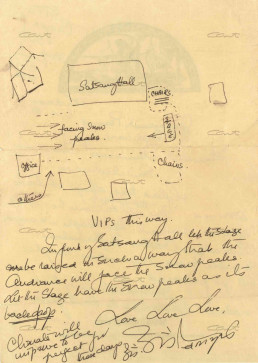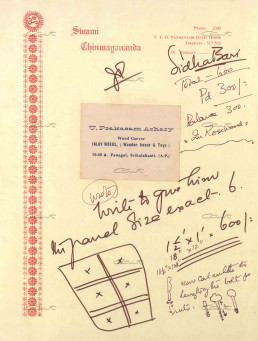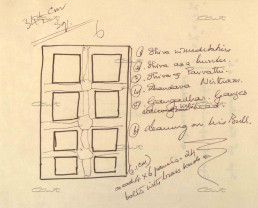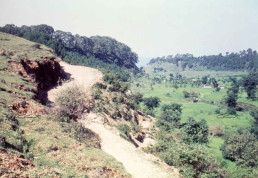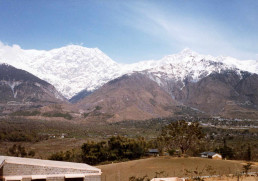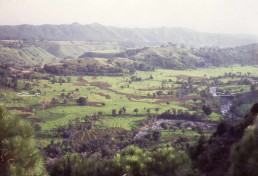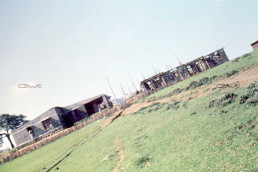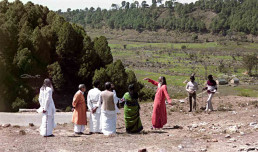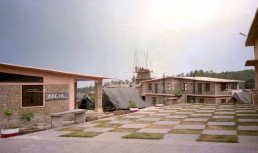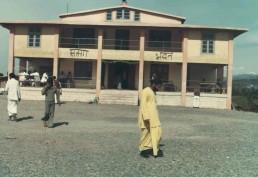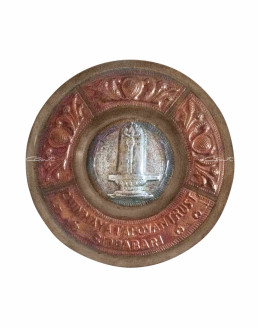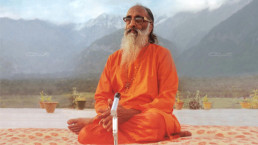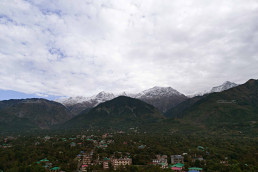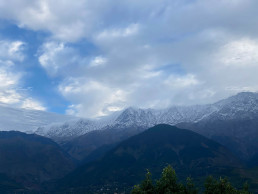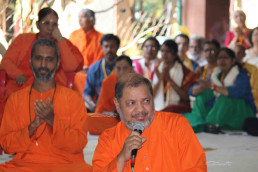Spiritual Camps
Sidhbari is synonymous with Pujya Gurudev’s unforgettable spiritual camps. Pujya Gurudev would say: “It is absolutely necessary for spiritual Sadhaks to dry-dock to a quiet place like Sidhbari and listen to the spiritual Masters, deeply reflect on them, and lift the mind in contemplation on the Reality.”
The life force in Chinmaya Tapovan ashram is Vedanta. While Sandeepany HIM is the site for the two and a half years full-time Vedanta courses for enrolled students, Pujya Gurudev opened up the gates of the Sidhbari ashram to share the inspiring scriptures with people from all walks of life. So, Sidhbari is synonymous with the unforgettable camps that Pujya Gurudev first started which the Chinmaya Guru Paramapara continues.
In 1981, the inaugural year of the ashram, Pujya Gurudev invited the world to experience the bliss of the first camp at Sidhbari with Vivekachoodamani, the poetic Vedantic composition of Bhagavan Adi Shankaracharya. From Sep.4th – Oct.28th, 1981, Pujya Gurudev taught the exquisite text of 581 verses in five historic camps where he took the blessed audience to the enthralling heights of Vedanta.




It was the time when Sidhbari was hardly known, and the amenities in the ashram were the bare essentials. There were hardly any cottages or even beds. Yet, the sheer power of Gurudev’s discourses and the exalted subject matter swept everyone off their feet into a realm beyond physical wants.
Those first five camps were a magical penance with a routine that reined in the wandering senses and redefined time. Pujya Gurudev encouraged all to use the spiritual retreat as a time to embark on a single-pointed quest for the Highest. It was a time for temporary sannyas – to renounce the noisy wants of the world and step into the silence of the Self.
The 5 am meditation sessions with Gurudev were blissful. The eloquent brilliance of Gurudev’s examples in his daily discourses at 6:30 am and 7:30 pm had the audience spellbound. Gurudev directed delegates to walk in solitude through the pine forest for some time in the day to introspect in deep silence. The discussions and question-answer sessions with Brahmachari Vivek Chaitanya, the first Acharya of Sandeepany Himalayas, increased understanding. The evening satsangs in the ethereal dusk of Sidhbari uplifted all to the peaks of reflective stillness.
While the intellect was steered toward clarity, the heart was softened to experience the purity of devotion. The collective Vishnu Sahasranama Archana and the trip to the stream to offer the flower petals after the puja made hearts soar and sing with divine joy. The Paada pujas offered to Pujya Gurudev’s holy Feet were full of reverence.
The fragrance of knowledge and devotion also came through in the routine of those camps when all attendees could assist and volunteer in different ways during the days.
There were other special events that made these early camps stand out even more. The Dalai Lama visited Chinmaya Tapovan for a special satsang on October 3rd, 1981 during the third camp.
Oct.27th, 1981, during the fifth camp, Pujya Gurudev consecrated the very special idols of Sri Kirata Murti Shiva and Parvati along with Lord Ganesha in an intricately carved Mandap inside the Satsang Hall. He narrated the story of Arjuna being blessed with the Pashupataastra after Shiva, in a hunter’s guise, tested and wiped out Arjuna’s arrogance. Arjuna learned the importance of humility and complete surrender.
Even today, those reigning idols inside the Satsang Hall are Pujya Gurudev’s reminder to us about the importance of surrendering our vasanas during satsang.
When the final camp of the first Vivekachoodamani series concluded on Oct.28th, 1981, Gurudev conducted the landmark convocation ceremony, a tradition he had started since the first camp. Pujya Gurudev applied the chandana tilaka to bless each attendee and gave a certificate to recognize the completion of the verses in that session. Then, each attendee carried a lamp lit from the Akhanda Jyoti at Swami Tapovan Maharaj’s altar and placed it on their home-states on a map of Bharat. With that unique ritual, Pujya Gurudev emphasized the importance of each seeker spreading the light of knowledge in their hometowns.
Pujya Gurudev conducted about 43 camps in Sidhbari expounding on a vast range of introductory and Upanishadic texts. In several of the camps, Brahmachari Vivek Chaitanya melted hearts with his discourses on Tulsi Ramayana, sweetening the flowing Knowledge with nectarine devotion.
After those iconic camps of 1981, the flow of Knowledge, Jnana Ganga, from Sidhbari was incessant. Pujya Gurudev called the spiritual camps as a port for spiritual dry-docking. He said: “‘You all have come here for dry-docking, It is a must for spiritual Sadhaks. The ships, after a few voyages in the ocean, are dry-docked for a complete rehauling and repairs. It is absolutely necessary for spiritual Sadhaks to dry-dock to a quiet place like Siddhabari and listen to the spiritual Masters, deeply reflect on them and lift the mind in contemplation on the Reality. This constant listening, thinking and contemplating helps the corroded mind to drop all its dross that it gathered during its sojourn in the ocean of Samsaar. A mind thus repaired and properly tuned up, can expand and lift itself to a state of Pure Awareness and Bliss.”
Chinmaya Tapovan Sidhbari is truly a vibrant spiritual port. Throughout the years, many Swamis and Acharyas ferry their devotees from all over the world to ‘dock’ in the soothing serenity of Sidhbari. Spiritual camps in Hindi, English, and the regional Indian languages are conducted regularly, and the camp routine that Pujya Gurudev initiated is still implemented. Meditation, daily discourses, discussions, Q&A sessions, seva opportunities, bhajans, and the famous treks in the pine forests are key attractions. Pujya Gurudev’s Paduka Puja is a worshipful experience. And, the field trips to the Gaushala and CORD premises are cherished by all.
The camps also reach out to a varied audience. Chinmaya Tapovan Trust graciously hosts yearly CHYK camps, management camps, educational trips from Chinmaya Vidyalayas and colleges. The complete experience in Sidhbari is an uplifting, continuous blessing.
Spiritual Camp Videos
Camp attendees placed lamps on their home states after camps in the early years.
Paada Puja offered by the sisters of Pujya Gurudev
Pujya Gurudev used to distribute Prasada in a loving way after Paada puja.
Pujya Gurudev's powerful explanation of Sat-Chit-Ananda during a camp in Sidhbari
Pujya Gurudev enjoying a Malayalam bhajan before a bhiksha in Sidhbari
Pujya Gurudev enjoying a Pahadi bhajan
Navigation
Next Topic
Spiritual Camps
Sidhbari is synonymous with Pujya Gurudev’s unforgettable spiritual camps. He would say: "It is absolutely necessary for spiritual Sadhaks to dry-dock to a…
Home Page
Nothing found.
Previous Topic
Spiritual Camps
Sidhbari is synonymous with Pujya Gurudev’s unforgettable spiritual camps. He would say: "It is absolutely necessary for spiritual Sadhaks to dry-dock to a…
Ram Mandir
The presence of a devotee draws the Lord without fail. Pujya Gurudev carefully planned the location of the Ram Mandir such that the eyes of Sidhbari Veera Hanumanji could forever gaze at the Lotus Feet of Bhagavan Rama.

The first Hanuman Mastakabhishekam completed on Oct.10th, 1982, showered the funds to lay the foundation for a unique temple – the first temple for Sri Rama and His Consort Sita in the Himachal land where, though Tulsi Ramayana was revered, most temples were for Devi or Shakti.
On March 6th, 1983, during the Bhoomi puja, Pujya Gurudev remarked that the temple would be a Setu, bridging the cultures of North and South. And, the idols to adorn the temple were Vanavaasi Rama and Sita – their austerely beautiful forms during their exiled 14-year forest life. The idols were carved from soft black stone by a famous sculptor Sri B. Basavanna of Mysore.
While explaining the significance of the Vedic rituals after the Bhoomi Puja, as the divine idols of Sri Rama and Maata Sita were unveiled, Pujya Gurudev, with His typical humour, pointed out that “Lakshmana had gone to collect fruits!” Maybe Pujya Gurudev wanted us to remember that Lakshmana-like Vairagya must be in our hearts in a life of Tapas and Bhakti.
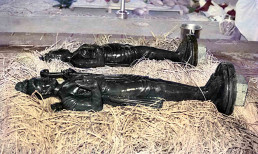
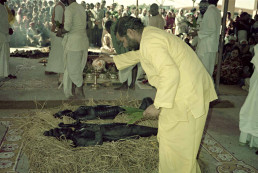
The Dhaanya Adhivaasa ritual on March 6th, 1983, was highly significant. The exquisite idols of Sri Rama Sita gracefully placed on a bed of grains to await installation were a heavenly sight. When people offered grains and even silver coins to the idols, Pujya Gurudev emphasized the importance of surrender, both spiritual and material.
A rare aspect of the Vanavaasi Ram Mandir is how the main altar of the temple is truly and literally founded on intense worldwide prayers. In response to Gurudev’s call for a Likhita Japa Yajna, 7844 devotees from 24 countries wrote “Om Sri Ram Jaya Ram Jaya Jaya Ram.” The total count of the written Japa was 28,84,875 when they were reverentially placed in the enclosure below the inner shrine.

Pujya Gurudev carefully planned the location of the Ramaalaya such that the eyes of Sidhbari Veera Hanumanji could forever rest at the Lotus Feet of His beloved Lord Rama. And, Pujya Gurudev emphasized how the ‘Kurma’ placed in the threshold of Sri Ram Mandir reminds devotees to withdraw all wandering senses for a fulfilling darshan of Bhagavan Rama.
The Mandir construction was completed in a record six months. Pujya Gurudev once remarked that “Hanumanji Himself was literally building the temple!” The entire Mandir is an aesthetic masterpiece of sacred beauty and symbolism.
In the video excerpts below, Sri Hemachandrudu of Lakshmi Constructions, Chennai, recalls the large-hearted love of Pujya Gurudev when credits were given for the temple construction.
The Kumbhabhishekam of the Vanavaasi Ram Mandir was a momentous three-day celebration with notable events. Oct.21st, 1983, began with Pujya Gurudev initiating a great blessing to Chinmaya Mission’s future. In a special diksha ceremony, Brni Yamuna Devi became Swamini Gangananda and Br. Radhakrishnan became Swami Jyotirmayananda. Br. Vivek Chaitanya, the first acharya of Sandeepany Himalayas was given sannyasa diksha to become the beloved Pujya Guruji Swami Tejomayananda, the global head of Chinmaya Mission from 1993 to 2016.
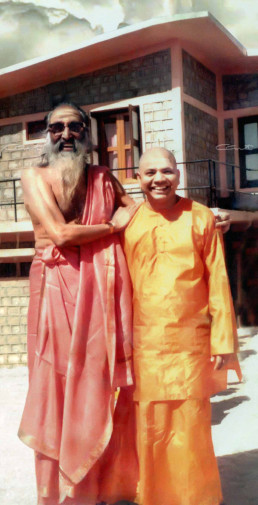

The whole atmosphere of Chinmaya Tapovan ashram was surcharged with spiritual vibrations on Oct.22nd when the newly initiated Swamis performed Kumbhabhishekam amid akhanda chanting of “Om Rama Ramaya Namah,” preliminary homa, pujas, archanas, and a Kalasha procession – all conducted flawlessly in Vedic style which filled the hearts of everyone.
Later on, when Pujya Gurudev performed Prana Pratishta to invoke Bhagavan’s Presence in the idols within the temple, the faces of Vanavaasi Rama Sita shone with a divine glow.
The consecration continued on Oct.23rd with the installation of Lord Ganesha and the Utsava Murtis – the idols of Ram Parivar.
Rare is the opportunity to witness a temple’s consecration. The devotees in Sidhbari, from the Governor of Himachal Pradesh to the simple Pahadi villager, were overjoyed by the grand celebrations of the Maha Kumbhabhisekham.
Today, as we prostrate inside that incomparable Vanavaasi Ram Sita Mandir in Sidhbari, we realize that here is an auspicious sanctum where Pujya Gurudev showed us the joy of penance, purity, deep faith, and devoted work.
From Veera Hanuman to Sri Ram - A panoramic view
Ram Mandir Videos
A glimpse of the Likhita Japa books which were later placed under the altar
Pujya Gurudev does Prana Pratishta for the newly installed idols.
Navigation
Next Topic
Ram Mandir
The presence of a devotee draws the Lord without fail. Once Veera Hanuman took up his abode in Sidhbari, His beloved Lord Rama also had to come there.
Home Page
Nothing found.
Previous Topic
Ram Mandir
The presence of a devotee draws the Lord without fail. Once Veera Hanuman took up his abode in Sidhbari, His beloved Lord Rama also had to come there.
Veera Hanuman
With the site for the ashram purchased, the next challenge was the forceful gales of winds and heavy rains. The land was barren as strong winds uprooted vegetation, and heavy rains caused boulders to come hurtling down from the mountains. Slates of rock and piles of sand brought in for construction would be thrown around and blown away overnight. No high-rise building could even be attempted in the windy, high altitude among the mountains and open land. As Pujya Gurudev observed this hurdle, he declared and invoked, “Let Vayuputra Hanuman be here.”
Facts
CONSECRATION
October 10th, 1982
DESIGN
Initial sketch by Pujya Gurudev
Prototype and Sculpture by Shri Kashinath Shilpi
Statue: 16-feet
Granite Base: 6-feet
NOTES
Verses from Tulsi Ramayana selected by Pujya Guruji Swami Tejomayananda adorn the granite base.
Over 5,000 attended the first Mastakabhishekam.
Early photographs
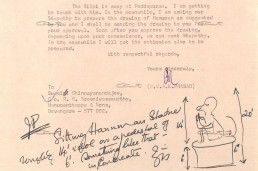

Awe-inspiring, alert, and magnificent, Vayuputra Shri Hanuman is a powerful presence in the Chinmaya ashram at Sidhbari. Calming the gusty winds across an open landscape with His powerful yet compassionate glance, the majestic Lord sits in veerasana ready to serve both Shri Ram whom He holds in His heart and the devotees who adore and approach Him.
It was the vision of Pujya Gurudev Swami Chinmayananda that sketched the arrival of the 22-feet idol of Shri Hanumanji at Sidhbari. Seeing how the fertile land of Sidhbari stood bare because of the strong winds, Pujya Gurudev invoked the Presence of Vayuputra Hanuman. His simple sketch in a letter (1981) to a longtime devotee marked the birth of the 16-feet towering idol atop a 6-feet pedestal. Gurudev knew – where the son will be, the Wind-God father will move with gentle affection! Thus was invited Vayuputra Shri Hanuman to watch over the Sidhbari ashram as construction progressed smoothly.
The son of Wind-God would be gigantic. As the Tejasvi Amshavatara, the son of Lord Shiva born in Mother Anjana’s womb through Vayu as His instrument, the Vayuputra had to be there to serve and support future growth. Though He held His mace (gadha) with powerful grace, He would kneel in devotion, ready to serve His Lord Rama who would arrive in the ashram a few years later! As Hanumanji took form in Sidhbari, the winds grew calmer, and the land rejoiced with lush fertile growth.
Here is a transcript of the interview with Shri Kashinath Shilpi and his crew who came to sculpt the splendid Shri Hanumanji. After the Vayuputra idol was completed and stood victorious in Sidhbari, divinity manifested all around in the structures built. The massive Shivalingam that crowned Pujya Gurudev’s kutiya signaled auspiciousness all around, and the idol of Nandi in front of the kutiya was the ready vehicle for service.
Mastakabhishekam
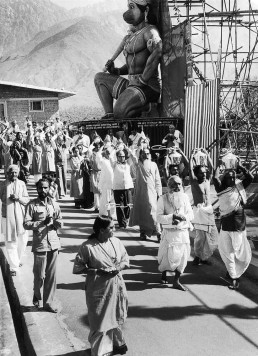
It was important to offer gratitude and worship to the supreme sevak, Sri Pavanaputra Hanuman. So, in 1982, Pujya Gurudev inaugurated the tradition of the once-in-five years Mastakabhishekam in Sidhbari. Mastaka means the head; the ritual of Mastakabhishekam is a consecration ceremony where an idol is bathed from head to feet. Pujya Gurudev wanted the whole of Sidhbari to rejoice and pray as the lustrous 16-ft Hanumanji atop the 6-ft pedestal would be consecrated with Panchamruta Abhishekam from crown to feet. It was a ceremonial bathing of the idol from the Mastaka(head) to toe. The preparations were elaborate and enthusiastic. A ramp over 90 ft long was constructed by the army personnel of the Yol Cantonment; an energetic CHYK contingent from Chennai delighted all with their dedicated seva. Hanuman Chalisa, bhajans and satsangs infused bhakti and Jnana in joyous harmony. A team of learned priests led by Sri Subbarama Sastrigal began the Vedic rites on the evening of October 8, 1982. October 9th was a day of many prayerful homams followed by the Kalasha Staapanam. A thousand and one pots/kalashas assorted in gold, silver, stainless steel, brass, copper and mud were filled with Ganga water, milk, curd, turmeric, or sindoor, and sanctified by pujas, archanas, chanting, and arati. The vibrations divinized the entire surroundings.
When Pujya Gurudev followed the priests and led the procession of devotees and dignitaries with a Kalasha on his head on the morning of October 10th, the devotion, discipline, and dedication of the entire gathering became a worshipful legacy of Chinmaya Tapovan Sidhbari. This was the first time that the people of the Himalayan valleys witnessed and participated in such a grand event. Truly, Pujya Gurudev began a beloved tradition of Sidhbari. The Mastakabhishekam that happens once every five years continues to be an event that brings together the Pahadis and people of all countries to convey their adoring gratitude to the Supreme Sidhbari Hanumanji who epitomizes alert wisdom, divine strength, deep devotion, and the supreme spirit of seva.
As we gaze at Sri Hanumanji’s form seated in the Veerasana pose, ready to serve Bhagavan Rama in His Heart, we realize that Pujya Gurudev embedded, in that magnificent idol, the message of devotion and seva with selfless dedication.
Below is a timeline with key details of the Mastakabhishekams that have continued since 1982.
HISTORY
Every five years, a Mastakabhishekam is performed to Lord Hanuman at Sidhbari. Below is a brief chronicle of this momentous event over time.
In 1982, when Shri K. Kashinath Shilpi had completed the construction of the idol (here is a transcript of the interview with Shri Kashinath), Pujya Gurudev planned the first Mastakabhishekam to consecrate and invoke the power of Lord Hanuman into the beautiful idol seated under the open skies according to Vedic traditions. To perform an abhishekam (the divine bathing ceremony) from the crown to feet of the towering idol that rose about 22 feet, a ramp that extended over 90 feet from the ground to the top was erected by the army personnel of Yol Cantonment. It was decorated by pine tree branches carefully picked with devotion and reverence to Nature. The energetic Chyks from Chennai led by Swami Siddhananda were a great help in this inaugural consecration.
The rituals began on October 8, 1982. As the Vedic vibrations filled the air, Pujya Gurudev guided all devotees to a continued chanting, “Om Sri Ramadhootaya Namaha.” Br. Vivek Chaitanya (now Swami Tejomayananda) added the melody of devotion inspiring them to also sing the Hanuman Chalisa. When lightning and thunderous rains filled the skies two days before the abhishekam, Pujya Gurudev Swami Chinmayananda remarked: Perhaps Varuna and Indra wanted to do the abhishekam first and give their benediction!
October 9 was a pious day of homams and kalasa sthapana. Thousand and one kalasas (pots) in gold, silver, brass, stainless steel, copper, mud filled with either water from Ganga or milk, curd, turmeric or sindhoor were divinized with invocations and worship (Aavaahanam and Sahasra Archana). As those rituals concluded, Sri Hanumanji’s idol was unveiled that evening after Arati.
When October 10th dawned, the Mastakabhishekam drew about five thousand people worldwide, including army personnel, government officers, and joyful people from the villages that surrounded the beautiful Sidhbari. As the priests followed by Pujya Gurudev, dignitaries, and devotees walked up the ramp with the sanctified Kalasas to perform the abhishekam, bathing Lord Hanuman’s form from crown to foot, the entire gathering was immersed in devotion with reverential chanting. Worship (Archana) with adornment (Alankara) and arati culminated with a long vada mala offered to the newly consecrated lustrous Lord; Vayuputra Hanuman stood blessing all of Sidhbari.
That first abhishekam on October 10, 1982, marked the onset of the 5-year tradition surrounding Shri Hanumanji at Sidhbari.
With the holy waters from the Ganga of Haridwar, the Kalasas were anointed as the homam rituals again purified the air to mark the 5-year milestone after the first consecration of the Sidhbari Vayuputra. It was a heartwarming sight to watch Pujya Gurudev Swami Chinmayananda race up the ramp which was built by the local villagers.
Pujya Gurudev led the Abhishekam procession energized by the sonorous chants of “Om Sri Ramadutaya Namaha.” Fireworks lit up the skies as the procession moved from the idol of the greatest Sevak Hanumanji to also perform the Abhishekam of His Master, the Supreme Lord Vanavasi Rama and Mother Sita at the Rama Mandir in Sidhbari.
This was the last Mastakabhishekam performed by Pujya Gurudev before His mahasamadhi in 1993.
Held a day after the memorable Vivekachoodamani camp of Pujya Gurudev, the third Mastakabhishekam was marked by elaborate preparations and excellent support by an earnest group of army personnel from the Yol cantonment who had erected an iron ramp and railing for the abhishekam. A sacred ceremony of Kalasa sthapana was followed by another hallowed reconsecration ceremony that filled hearts with grateful devotion toward the imposing guardian Lord of Sidhbari.
Set inside a beautiful mantap, 390 kalasas were brimming with the holy waters from the Manasarovar to the southern rivers and seas. Vedic scholars from Delhi (led by Sri Subbarama Shastri) initiated the ceremony with elaborate homams and performed puja to those kalasas. Notable were the three Pradhana Kalasas – for Lord Rama, Lord Hanuman, and one honoring Pujya Gurudev Swami Chinmayananda who had attained Mahasamadhi in 1993. When Pujya Guruji Swami Tejomayananda and other acharyas offered abhishekam with the sanctified waters, it was as though Tejasvi Hanuman was beaming down on the hundreds of devotees. As Hanumanji glowed even more in the Arati after vastra (new clothes) and garlands were offered, a gentle rain from the skies seemed to carry the joy of the heavens down to Sidhbari.
The skies over Sidhbari poured in anticipation, two days before the 5th mastakabhishekam in 2002. On the day of the abhishekam, priests carried the three Pradhana Kalasas from Kamala Hall while Pujya Guruji Swami Tejomayananda and the acharyas held the kalasas on their heads and performed the Mastakabhishekam amid devoted, enthusiastic chanting of Om Sri Ramadutaya Namaha. Later, as the face of Shri Hanuman shone in the Arati, the sun smiled between the parting clouds as if joining the celebration to delight all.
After gaining inspiration from Pujya Guruji’s camp on Hanuman Chalisa, the silver jubilee Mastakabhishekam started off melodiously with a musical concert by Pandit Jasraj. Then began the Vedic preparatory rituals of pujas and homams under the leadership of Shri Subbarama Shastri as four Pradhana Kalashas ready to be specially offered to Sri Rama, Lord Shiva, Lord Hanuman, and Pujya Gurudev adorned the top of the pyramid of 1000 kalasas.
Everyone wanted to offer their best to Shri Hanumanji – the Indian Army built a special ramp with much devotion; specialists from Brindavan, at Swamini Gurupriyananda’s request, decorated the place with flowers. When Pujya Guruji led the Mastakabhishekam procession in an atmosphere of fervent chanting and joyful Pahadi Bhajans, Shri Hanumanji’s face reflected the joy of His devotees. The special offerings of garlands, tulsi mala, angavastram, silver anklets, and a gold-embossed red belt with “Sri Ram Jay Ram ” lettered on it added the festive silver touch to the glowing Lord.
Keeping with the Vedic traditions, the 7th reconsecration ceremony was performed with great devotion and delight under the leadership of Pujya Guruji. The faithful gathering of villagers, army personnel, and devotees gazed on at the mesmerizing form of the mighty Shri Hanumanji during the Mastakabhishekam. When beautiful flower petals were showered on the huge form of the Lord after the ceremony, all hearts were bathed in great happiness.
In 2017, Mukhya Swami Swaroopananda performed the 8th Mastakabhishekam in the presence of Pujya Guruji Swami Tejomayananda. Once again, the unbroken chanting of “Om Sri Ramadutaya Namaha” and Anjaneya Sahasranama Archana sanctified the air as kalasa pujas and homams were performed by Sri Subbarama Shastri and his team. The abhishekam, as always, transported everyone who witnessed it into a realm of deep devotion that was colored with great joy when beautiful flowers were showered on Shri Vayuputra! The Lord continued to shine with new clothes, fragrant garlands, and a long pearl necklace that gained beauty because of adorning His luminous Form. It was a spectacular ceremony, and we present highlights of that 2017 consecration event.
The ninth Mastakabhishekam of Sri Veera Hanuman at Sidhbari was conducted in a memorable ceremony that spanned the days of Oct.8-10, 2022. The celebratory worship began on Oct.8 with great prayers offered during the Anjaneya Utsava Murthy puja. The eyes and hearts of all devotees were riveted on the resplendent idol of Shri Hanuman throughout the beautiful abhishekam as Swami Sharadananda conducted the elaborate puja. Following that, the Guru Puja at Pujya Gurudev’s Samadhi Sthal and the Guru Anugnya paada pujas of Pujya Guruji and Pujya Swami Swaroopanandaji indicated how the Grace of the Chinmaya Guru Parampara would be the guiding force for this Mastakabhishekam.
During the Kalasha Sthapana rituals, the colorful backdrop of the ceremonial pots signifying the five elements of space, air, fire, water, and earth was meaningful and eye-catching. The Vedic homams culminating with the purnahuti, and the rituals of Sri Rama Sahasranama Archana and Sri Hanuman Sahasranama Archana purified and permeated the entire surroundings in the ashram setting the stage for a grand Mastakabhishekam. On the chill and misty morning of Oct.10th, when Pujya Guruji and Pujya Swami Swaroopanandaji performed the Mastakabhishekam of the majestic Lord Hanuman with Panchamruta, turmeric and kumkum waters, all devotees onsite and online were moved by the divine beauty of the reconsecration ceremony in the scenic Sidhbari. Melodious bhajans by Pujya Guruji, Swamins, students of the 18th Vedanta course, devotees, and the Pahadi people added joy. The happy Garbha dances that brought people from far and near together added the sweet touch of happiness. Then, as the long line of devotees performing the abhishekam ended, the glowing idol of Vayuputra Hanuman was adorned with a beautiful garland and a bright saffron angavastram. When the festivities ended with Sri Hanuman Arati, it was evident that the 9th Mastakabhishekam had bathed and blessed all who witnessed it with joyful, grateful devotion.
Navigation
Next Topic
Veera Hanuman
Vayuputra Shri Hanuman is a powerful presence in the Chinmaya ashram at Sidhbari; awe-inspiring, alert, and magnificent. Pujya Gurudev invoked Veera Hanuman in…
Home Page
Nothing found.
Previous Topic
Veera Hanuman
Vayuputra Shri Hanuman is a powerful presence in the Chinmaya ashram at Sidhbari; awe-inspiring, alert, and magnificent. Pujya Gurudev invoked Veera Hanuman in…
Sandeepany Himalayas
In Sidhbari, Pujya Gurudev wished to train a new generation to propagate the spiritual culture of India. Thus, in a contemplative atmosphere, Sandeepany Himalayas grew into a full-fledged Vedantic Gurukula drawing seekers across the country to its fulltime Vedanta Course in Hindi.
In Sidhbari’s contemplative atmosphere, at the Himalayan foothills, Pujya Gurudev Swami Chinmayananda aimed to establish a Vedantic Gurukula in Hindi to spread the glory of Hindu scriptures and Sanatana Dharma. So, when the basic infrastructure in Chinmaya Tapovan ashram was ready, Sandeepany HIM (Himalayas) was inaugurated in a two-day event by Pujya Gurudev with joyous prayers and celebration. Sandeepany Himalayas, Sidhbari, would be the site for the Vedanta course in Hindi.
On April 25th, 1981, the Managing Trustee, Sri Jagadish Prasad, welcomed an eager gathering and spoke about the hurdles that CTT had crossed to reach the inaugural milestone that day. Then, Br. Vivek Chaitanya, who was chosen to be the first Acharya of the Hindi course, spoke on “Our Students,” explaining the process of how brahmacharis were selected for the course. After that, he lit the Jyoti to symbolize that the ‘Lamp of Knowledge’ would burn bright at Chinmaya Tapovan ashram.

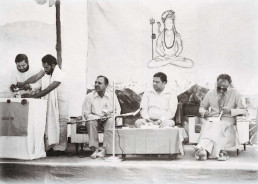
As the Chief Guest that day, Dr. Karan Singh, a Vedic scholar and statesman, applauded the efforts of Chinmaya Mission in spearheading the noble art of man-making during his address. Sri Hardayal, the Minister of Forests, presided over the ceremony. Pujya Gurudev then eloquently outlined the work and vision of CM, particularly in Himachal Pradesh.
The festivities also included a Pahadi lunch – another example of how Pujya Gurudev included the villagers in all undertakings at Chinmaya Tapovan. The Vishnu Sahasranaama archana conducted in the Satsang hall that evening and the Rudra-Path on the morning of April 26th were Gurudev’s way of showing how the path to knowledge is through devotion.
On April 26th, Pujya Gurudev shared his visionary plan for Sandeepany (HIM) in the session where Sri Ram Lal, the Chief Minister of Himachal Pradesh at that time, presided as the chief guest. The Himachal government assured full cooperation for the initiatives at Chinmaya Tapovan ashram. Sandeepany (HIM) had a memorable start.
It was at Sandeepany (HIM) that Pujya Gurudev conferred sannyasa diksha on Brahmachari Vivek on October 21st, 1983, to give us Swami Tejomayananda, Pujya Guruji, who became the global head of Chinmaya Mission from 1993 to the end of 2016. The Vedantic teaching that Swami Tejomayananda began in Sandeepany continues to this day with Pujya Gurudev’s Grace. Another beloved Resident Acharya of Sandeepany (HIM), Swami Subodhananda, taught three full Vedanta courses and transformed many. A notable contribution of Sandeepany (HIM) is that it was the holy site of sannyasa diksha for several senior Swamis since then.
The flow of Jnana and Bhakti have continued throughout the last 12 courses with the Chinmaya Guru Parampara illuminating the path to the Highest. The 13th Vedanta course concludes on May 8th, 2023, and the glorious learning will continue.
Chinmaya Tapovan Trust which mindfully manages the ashram activities, shares how Sandeepany HIM continues to fulfill Pujya Gurudev’s vision: “Over 113 students are working for the Mission as of 2023. Many are Swamis now. The area of operation for students of Sandeepany HIM is predominantly those centers where the Hindi language is more prominent. They are posted mainly in centers which are in Uttar Pradesh, Madhya Pradesh, Punjab, Odisha, and Rajasthan, and some in Maharashtra and Gujarat.”
Chinmaya Tapovan Sidhbari is undoubtedly a Sandeepany Gurukula spreading the light of Vedantic Knowledge across Himachal Pradesh and other Hindi-speaking areas.
History of the Vedanta Course at Sandeepany Himalayas

Doing Puja with Grace
Pujya Gurudev explains how to offer flowers during a puja in the Satsang Hall.
Navigation
Next Topic
Sandeepany Himalayas
In Sidhbari’s contemplative atmosphere, at the Himalayan foothills, Pujya Gurudev Swami Chinmayananda aimed to establish a Vedantic Gurukula in Hindi to spread…
Home Page
Nothing found.
Previous Topic
Sandeepany Himalayas
In Sidhbari’s contemplative atmosphere, at the Himalayan foothills, Pujya Gurudev Swami Chinmayananda aimed to establish a Vedantic Gurukula in Hindi to spread…
Sidhbari Kutiya
Pujya Gurudev Swami Chinmayananda was truly at home anywhere He went. And for all devotees, His Kutiya in Chinmaya Tapovan Sidhbari is a special temple.
Pujya Gurudev’s Kutiya was one of the first buildings that came up on the desolate hillock of Sidhbari. With Dharamshala on the left and the Yol Cantonment on the right, its location is scenic. The mighty Dhauladhar mountains are a stunning backdrop. Indeed, today, when we enter Pujya Gurudev’s Kutiya, we feel at once the calming sense of being in the warm Presence of an extraordinary Guru. We can almost hear His powerful voice calling out in our hearts, “Hari Om!”
In 1976, Pujya Gurudev wrote to Colonel L.S. Pathania with an outline of his plans. That letter is shown below. He then carefully supervised the construction so that minimum resources were used.

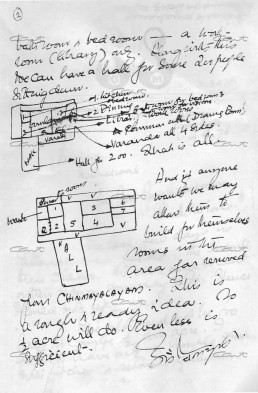
Photos of the Kutiya - Then to Now
The vibrant Presence of Pujya Gurudev and the accompanying deep silence is unmistakable in every room of the Kutiya, as it flows into our deeper consciousness. He also intended that the Kutiya would be more than just His place of residence in the Sidhbari ashram. The sitting cum dining hall was also the satsang hall where Gurudev gave so freely of Himself to transform countless lives. The dining area brings to our minds the warm memories of His loving appreciation, of course sweetened by His great sense of humour during countless bhikshas! When we stand in front of His Padukas in that satsang Hall, and gaze at the portraits of Parama Guru Swami Tapovanam and Him, waves of gratitude and respectful love floods us. The old television still preserved in that room reminds us of Pujya Gurudev reclining there watching tennis tournaments and tapes of Mahabharata and Srimad Bhagavatam while recuperating from setbacks in health. We are filled with wonder about His indomitable spirit full of life with His Vedanta-in-Tennis commentary during those challenging times.
When we look at His meticulous office desk with the stationery, we can visualize the kind, attentive face of Pujya Gurudev writing one of His letters that devotees still treasure. Truly, Pujya Gurudev’s office desk was His altar, and writing was His puja.
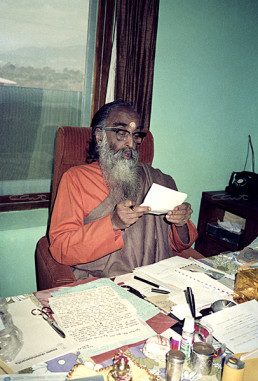
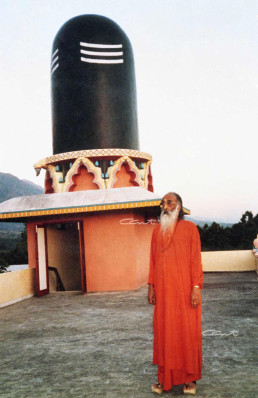
At the top of the kutiya, he had a Shiva Linga installed. In his own words: “The ellipse represents our cosmos. If that ellipse is half-buried what is seen on the surface is a Shiva Linga, which represents the manifested and therefore visible part of the Cosmos. This is then supported by the other half of the ellipse hidden from our vision.”
He then had the Nandi placed in front of the Kutiya, facing outward, and said: “A man who has emptied his vasanas is Shiva, and such a person, if he has to function in the world, the vehicle should be ever-ready!”
The entire Kutiya of Pujya Gurudev is an emblem of spiritual steadfastness, endless benevolence, and all-encompassing knowledge. It is a place of most treasured memories, where we feel so close to our dearest Pujya Gurudev. Pujya Swami Swaroopanandaji shares his thoughts below.
Pujya Gurudev’s Kutiya at Sidhbari holds deep meaning for devotees and spiritual seekers. In this section, we present important artefacts and images from that revered abode of the renowned Master.
In this section, we present important artefacts and images from that revered abode of the renowned Master.
As we mindfully “walk” through Gurudev’s Kutiya, let us invoke His Presence that inspires and transforms the very way we view the different parts of the home that call out “Hari Om!”
Doors to the Kutiya and the Meditation Room
Scroll horizontally to see photos or
click/touch to expand.
Visitors’ Room in Sidhbari
Pujya Gurudev’s Bedroom
Library Space
Office area and desk
Satsang Hall/Sitting and Dining Rooms
Artefacts
Kutiya Videos
Navigation
Next Topic
Sidhbari Kutiya
A focal point of Sidhbari, Pujya Gurudev’s Kutiya holds deep meaning for devotees and spiritual seekers. In this section, we present important artefacts and…
Home Page
Nothing found.
Previous Topic
Sidhbari Kutiya
A focal point of Sidhbari, Pujya Gurudev’s Kutiya holds deep meaning for devotees and spiritual seekers. In this section, we present important artefacts and…
The Preparation
Noble as the beginning was, it required labor, penance, and patience. Steadily, with Pujya Gurudev’s astute guidance at every step, the barren hillock in the Kangra valley slowly transformed into Chinmaya Tapovan, Sidhbari.
Pujya Gurudev’s resolve was divine, and His vision held clear conviction. Where everyone else saw a bald hill, Pujya Gurudev sighted great potential! Noble as the beginning was, it required labor, penance, and patience. In the tapas to procure the barren land from the government, a devotee Col. L.S. Pathania persevered, and soon the Chinmaya Tapovan Trust (CTT) was formed on March 24th, 1977 and registered under the Society Registration Act xx1 of 1860 with Sri Jagadeesh Prasad and a dedicated team to fulfill the noble purpose of spiritual learning and noble service. To commence construction, Bhoomi Puja was done on the auspicious Guru Poornima day of July 10th, 1979.

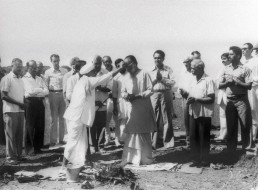

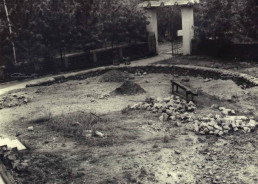
The initial years were full of challenges like poor road access, intermittent electricity, and difficulty with water supply; it was almost past the September of 1979 that work actually began onsite. Yet, when Pujya Gurudev voiced his sankalpa for the ashram inauguration to be on April 24th, 1981, his faith energized all to work together and complete construction of most of the initial buildings within 18 months despite two bitterly cold winters and heavy monsoon rains.
In the following years, infrastructure kept growing rapidly in the ashram. Every building that came up was carefully overseen by Pujya Gurudev. Devotees still speak in awe about His Yoga-in-Action when he was totally involved in the smallest detail but operated from a lofty undisturbed height.
In front of the Satsang Hall, Gurudev planned an open plaza for major events. “In front of Satsang Hall, let the stage be raised in such a way that the audience will face the snow peaks.”
The deep foresight in planning the best backdrop for the Satsang Hall along with an auspicious, intricately decorated entrance, the vigilant supervision of the Kutiya construction, the brilliant vision behind His sketch of Sidhbari Veera Hanumanji – His precision in anything was not just about physical perfection but a greater fulfillment.
Countless were such instances when devotees could see Gita teachings come alive in every step of Pujya Gurudev. The barren hillock in the Kangra valley slowly transformed into Chinmaya Tapovan, Sidhbari.
Navigation
Next Topic
The Preparation
Noble as the beginning was, it required labor, penance, and patience. But with Pujya Gurudev's astute guidance at every step the barren hillock in the Kangra…
Home Page
Nothing found.
Previous Topic
The Preparation
Noble as the beginning was, it required labor, penance, and patience. But with Pujya Gurudev's astute guidance at every step the barren hillock in the Kangra…
The Purpose
Pujya Gurudev had two clear aims for the ashram in Sidhbari. First, the essence of the scriptures must be spread among the Hindi-speaking people of the Himalayan region and North India. The second was to uplift the lives of the Pahadis, the natives of the Himalayan region, who had faithfully served the saints and sages in the mountains.
Parama Guru Swami Tapovan Maharaj had passed through the Kangra valley during his trek across the Kangra region. Walking in the footsteps of His beloved Guru many years later, Pujya Gurudev Swami Chinmayananda came to Sidhbari after finishing a yajna at Shimla in 1977. Instinctively tuning into its spiritual heritage, Pujya Gurudev could envision that Sidhbari would be home to Chinmaya Tapovan, a crest-jewel of Chinmaya Mission. Blessed by the ancient rishis and fit to be an apt spiritual legacy of Swami Tapovan Maharaj, the ashram at Sidhbari would be an offering of Chinmaya to Tapovan. There, the bliss of Knowledge (Chinmaya) would revel in a forest of penance (Tapovanam).
The time had also come for a greater debt to be repaid to the Pahadis who had served the sages and saints in the Himalayas for countless ages. Pujya Gurudev’s mission aimed to empower the people in the Himalayan valleys with the strengthening devotion of Tulsi Ramayana as well as the means to achieve healthier and economically better lives.
Pujya Gurudev knew that the work ahead may not be fully understood. In His words:
I am now turning my full attention to an aspect of the revival program which we had to seemingly neglect so far, as we had neither the leisure nor the required workers to serve the poor but noble people living in the interior villages of the Himalayas – the Pahadies; nor had we the workers for the Hindi areas.
I had been planning this for the last three years, scouting for the right place, discovering the required funds and building the campus for running the Sandeepany (HIM). In the Himachal Pradesh, in the rich Kangra Valley, just down below the famous Dharmsala, adjacent to the Yol Cantonment, we are now erecting a campus to accommodate 40 Brahmacharis to preach in the predominantly Hindi-speaking areas, and some 20 Brahmacharis to serve in the upper and interior areas of the Himalayas – from Kashmir to Almorah.
This is a gigantic work, amidst a people who cannot now see through our vision-oriented program, and so are at present, not so very enthusiastic about us and our work. That will not discourage us; and, we are sure we will soon catch their attention and compel their respectful admiration by the sheer benevolence of our services to their community.
The purpose was strong – to train a new generation who will carry the wisdom of Hindu Sanatana Dharma around the world. The promise was firm – the lives of the people of Himachal would be uplifted – materially and spiritually – through the grateful love nurtured by a global Master, a son of Sidhbari, Pujya Gurudev.
Chinmaya Tapovan Sidhbari would become the ashram of many blessings to the entire Himachal region and the world in the years to come.
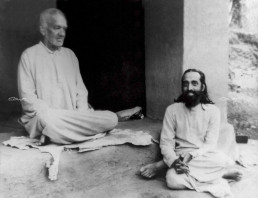
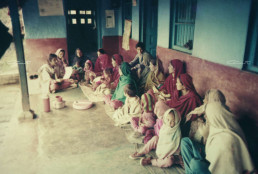
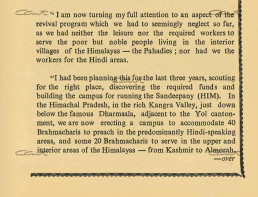
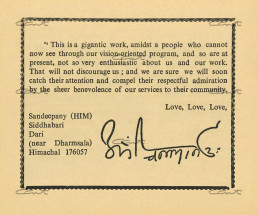
Navigation
Next Topic
The Purpose
Pujya Gurudev had two clear aims: first, to spread the essence of the scriptures among the Hindi-speaking people of the Himalayan region and North India and…
Home Page
Nothing found.
Previous Topic
The Purpose
Pujya Gurudev had two clear aims: first, to spread the essence of the scriptures among the Hindi-speaking people of the Himalayan region and North India and…
The Place
Sidhbari means the abode of Siddha Purushas (the spiritually enlightened). Nestled in the Dhauladhar mountains, Sidhbari in Himachal Pradesh, India, holds a special place in the heads and hearts of Chinmaya Mission devotees worldwide.
Sidhbari
Sidhbari, the abode of Siddhas, is a place of sacred significance, holding a special place in the history of Chinmaya Mission. Located in India’s Himachal Pradesh, Kangra District, about 7 kilometers away from Dharamsala, it is home to Chinmaya Tapovan and is the site of Sandeepany HIM (Sandeepany Himalayas). Named with great reverence by Pujya Gurudev in honor of Parama Guru Swami Tapovan Maharaj, the ashram in Sidhbari is a place where penance and devotion shine.
The very mention of Sidhbari redirects all our senses to serene sanctity. The divine land, Deva Bhoomi, where the sage Kapila Muni had spent some time in contemplation and imparted the Highest Knowledge with great love for His mother Devahuti evokes reverence.
The air feels ripe with peace from the deep meditation of many sages in ancient ages. The breathtakingly beautiful Dhauladhar mountains, the terraced paddy fields nourished by the gurgling streams, and the rich green of the pine forests transport us to a realm of deep wonder. The play of sun, snow, and clouds in the Kangra Valley mesmerize and usher in a fullness beyond words. It is this Sidhbari in Himachal Pradesh, India, that holds a special place in the heads and hearts of Chinmaya Mission devotees worldwide.
Getting there
CONTACT
Sandeepany (HIM)
Sidhbari 176 057
Himachal Pradesh, India
Ph: +91-1892-234 324
Fax: +91-1892-236 199
Email: ctt@chinmayamission.com
DIRECTIONS
Sidhbari Videos
Navigation
Next Topic
The Place
Nestled in the Dhauladhar mountains, Sidhbari in Himachal Pradesh, India, holds a special place in the heads and hearts of the devotees at Chinmaya Mission…
Home Page
Nothing found.
Previous Topic
The Place
Nestled in the Dhauladhar mountains, Sidhbari in Himachal Pradesh, India, holds a special place in the heads and hearts of the devotees at Chinmaya Mission…
Hanuman Mastakabhishekam
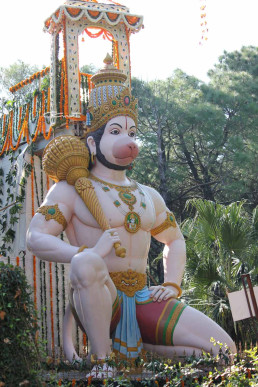
Introduction
Awe-inspiring, alert, and magnificent, Vayuputra Shri Hanuman is a powerful presence in the Chinmaya ashram at Sidhbari. Calming the gusty winds across an open landscape with His powerful yet compassionate glance, the majestic Lord sits in veerasana ready to serve both Shri Ram whom He holds in His heart and the devotees who adore and approach Him.
It was the vision of Pujya Gurudev Swami Chinmayananda that sketched the arrival of the 22-feet idol of Shri Hanumanji at Sidhbari. Seeing how the fertile land of Sidhbari stood bare because of the strong winds, Pujya Gurudev invoked the Presence of Vayuputra Hanuman. His simple sketch in a letter (1981) to a longtime devotee marked the birth of the 16-feet towering idol atop a 6-feet pedestal. Gurudev knew – where the son will be, the Wind-God father will move with gentle affection! Thus was invited Vayuputra Shri Hanuman to watch over the Sidhbari ashram as construction progressed smoothly.
Facts
CONSECRATION
October 10th, 1982
DESIGN
Initial sketch by Pujya Gurudev
Prototype and Sculpture by Shri Kashinath Shilpi
Statue: 16-feet
Granite Base: 6-feet
NOTES
Verses from Tulsi Ramayana selected by Pujya Guruji adorn the granite base.
Over 5,000 attended the first Mastakabhishekam.
HISTORY
Every five years, a Mastakabhishekam is performed to Lord Hanuman at Sidhbari. Below is a brief chronicle of this momentous event over time.
In 1982, when Shri K. Kashinath Shilpi had completed the construction of the idol (here is a transcript of the interview with Shri Kashinath), Pujya Gurudev planned the first Mastakabhishekam to consecrate and invoke the power of Lord Hanuman into the beautiful idol seated under the open skies according to Vedic traditions. To perform an abhishekam (the divine bathing ceremony) from the crown to feet of the towering idol that rose about 22 feet, a ramp that extended over 90 feet from the ground to the top was erected by the army personnel of Yol Cantonment. It was decorated by pine tree branches carefully picked with devotion and reverence to Nature. The energetic Chyks from Chennai led by Swami Siddhananda were a great help in this inaugural consecration.
The rituals began on October 8, 1982. As the Vedic vibrations filled the air, Pujya Gurudev guided all devotees to a continued chanting, “Om Sri Ramadhootaya Namaha.” Br. Vivek Chaitanya (now Swami Tejomayananda) added the melody of devotion inspiring them to also sing the Hanuman Chalisa. When lightning and thunderous rains filled the skies two days before the abhishekam, Pujya Gurudev Swami Chinmayananda remarked: Perhaps Varuna and Indra wanted to do the abhishekam first and give their benediction!
October 9 was a pious day of homams and kalasa sthapana. Thousand and one kalasas (pots) in gold, silver, brass, stainless steel, copper, mud filled with either water from Ganga or milk, curd, turmeric or sindhoor were divinized with invocations and worship (Aavaahanam and Sahasra Archana). As those rituals concluded, Sri Hanumanji’s idol was unveiled that evening after Arati.
When October 10th dawned, the Mastakabhishekam drew about five thousand people worldwide, including army personnel, government officers, and joyful people from the villages that surrounded the beautiful Sidhbari. As the priests followed by Pujya Gurudev, dignitaries, and devotees walked up the ramp with the sanctified Kalasas to perform the abhishekam, bathing Lord Hanuman’s form from crown to foot, the entire gathering was immersed in devotion with reverential chanting. Worship (Archana) with adornment (Alankara) and arati culminated with a long vada mala offered to the newly consecrated lustrous Lord; Vayuputra Hanuman stood blessing all of Sidhbari.
That first abhishekam on October 10, 1982, marked the onset of the 5-year tradition surrounding Shri Hanumanji at Sidhbari.
With the holy waters from the Ganga of Haridwar, the Kalasas were anointed as the homam rituals again purified the air to mark the 5-year milestone after the first consecration of the Sidhbari Vayuputra. It was a heartwarming sight to watch Pujya Gurudev Swami Chinmayananda race up the ramp which was built by the local villagers.
Pujya Gurudev led the Abhishekam procession energized by the sonorous chants of “Om Sri Ramadutaya Namaha.” Fireworks lit up the skies as the procession moved from the idol of the greatest Sevak Hanumanji to also perform the Abhishekam of His Master, the Supreme Lord Vanavasi Rama and Mother Sita at the Rama Mandir in Sidhbari.
This was the last Mastakabhishekam performed by Pujya Gurudev before His mahasamadhi in 1993.
Held a day after the memorable Vivekachoodamani camp of Pujya Gurudev, the third Mastakabhishekam was marked by elaborate preparations and excellent support by an earnest group of army personnel from the Yol cantonment who had erected an iron ramp and railing for the abhishekam. A sacred ceremony of Kalasa sthapana was followed by another hallowed reconsecration ceremony that filled hearts with grateful devotion toward the imposing guardian Lord of Sidhbari.
Set inside a beautiful mantap, 390 kalasas were brimming with the holy waters from the Manasarovar to the southern rivers and seas. Vedic scholars from Delhi (led by Sri Subbarama Shastri) initiated the ceremony with elaborate homams and performed puja to those kalasas. Notable were the three Pradhana Kalasas – for Lord Rama, Lord Hanuman, and one honoring Pujya Gurudev Swami Chinmayananda who had attained Mahasamadhi in 1993. When Pujya Guruji Swami Tejomayananda and other acharyas offered abhishekam with the sanctified waters, it was as though Tejasvi Hanuman was beaming down on the hundreds of devotees. As Hanumanji glowed even more in the Arati after vastra (new clothes) and garlands were offered, a gentle rain from the skies seemed to carry the joy of the heavens down to Sidhbari.
The skies over Sidhbari poured in anticipation, two days before the 5th mastakabhishekam in 2002. On the day of the abhishekam, priests carried the three Pradhana Kalasas from Kamala Hall while Pujya Guruji Swami Tejomayananda and the acharyas held the kalasas on their heads and performed the Mastakabhishekam amid devoted, enthusiastic chanting of Om Sri Ramadutaya Namaha. Later, as the face of Shri Hanuman shone in the Arati, the sun smiled between the parting clouds as if joining the celebration to delight all.
After gaining inspiration from Pujya Guruji’s camp on Hanuman Chalisa, the silver jubilee Mastakabhishekam started off melodiously with a musical concert by Pandit Jasraj. Then began the Vedic preparatory rituals of pujas and homams under the leadership of Shri Subbarama Shastri as four Pradhana Kalashas ready to be specially offered to Sri Rama, Lord Shiva, Lord Hanuman, and Pujya Gurudev adorned the top of the pyramid of 1000 kalasas.
Everyone wanted to offer their best to Shri Hanumanji – the Indian Army built a special ramp with much devotion; specialists from Brindavan, at Swamini Gurupriyananda’s request, decorated the place with flowers. When Pujya Guruji led the Mastakabhishekam procession in an atmosphere of fervent chanting and joyful Pahadi Bhajans, Shri Hanumanji’s face reflected the joy of His devotees. The special offerings of garlands, tulsi mala, angavastram, silver anklets, and a gold-embossed red belt with “Sri Ram Jay Ram ” lettered on it added the festive silver touch to the glowing Lord.
Keeping with the Vedic traditions, the 7th reconsecration ceremony was performed with great devotion and delight under the leadership of Pujya Guruji. The faithful gathering of villagers, army personnel, and devotees gazed on at the mesmerizing form of the mighty Shri Hanumanji during the Mastakabhishekam. When beautiful flower petals were showered on the huge form of the Lord after the ceremony, all hearts were bathed in great happiness.
In 2017, Mukhya Swami Swaroopananda performed the 8th Mastakabhishekam in the presence of Pujya Guruji Swami Tejomayananda.Once again, the unbroken chanting of “Om Sri Ramadutaya Namaha” and Anjaneya Sahasranama Archana sanctified the air as kalasa pujas and homams were performed by Sri Subbarama Shastri and his team. The abhishekam, as always, transported everyone who witnessed it into a realm of deep devotion that was colored with great joy when beautiful flowers were showered on Shri Vayuputra! The Lord continued to shine with new clothes, fragrant garlands, and a long pearl necklace that gained beauty because of adorning His luminous Form. It was a spectacular ceremony, and we present highlights of that 2017 consecration event.
The ninth Mastakabhishekam of Sri Veera Hanuman at Sidhbari was conducted in a memorable ceremony that spanned the days of Oct.8-10, 2022. The celebratory worship began on Oct.8 with great prayers offered during the Anjaneya Utsava Murthy puja. The eyes and hearts of all devotees were riveted on the resplendent idol of Shri Hanuman throughout the beautiful abhishekam as Swami Sharadananda conducted the elaborate puja. Following that, the Guru Puja at Pujya Gurudev’s Samadhi Sthal and the Guru Anugnya paada pujas of Pujya Guruji and Pujya Swami Swaroopanandaji indicated how the Grace of the Chinmaya Guru Parampara would be the guiding force for this Mastakabhishekam.
During the Kalasha Sthapana rituals, the colorful backdrop of the ceremonial pots signifying the five elements of space, air, fire, water, and earth was meaningful and eye-catching. The Vedic homams culminating with the purnahuti, and the rituals of Sri Rama Sahasranama Archana and Sri Hanuman Sahasranama Archana purified and permeated the entire surroundings in the ashram setting the stage for a grand Mastakabhishekam. On the chill and misty morning of Oct.10th, when Pujya Guruji and Pujya Swami Swaroopanandaji performed the Mastakabhishekam of the majestic Lord Hanuman with Panchamruta, turmeric and kumkum waters, all devotees onsite and online were moved by the divine beauty of the reconsecration ceremony in the scenic Sidhbari. Melodious bhajans by Pujya Guruji, Swamins, students of the 18th Vedanta course, devotees, and the Pahadi people added joy. The happy Garbha dances that brought people from far and near together added the sweet touch of happiness. Then, as the long line of devotees performing the abhishekam ended, the glowing idol of Vayuputra Hanuman was adorned with a beautiful garland and a bright saffron angavastram. When the festivities ended with Sri Hanuman Arati, it was evident that the 9th Mastakabhishekam had bathed and blessed all who witnessed it with joyful, grateful devotion.
Mastakabhishekam Videos
Related Topics
Related Topics
Nothing found.
Sidhbari, Hanumanji, and Gurudev
The Sankalpa for Sidhbari
Sidhbari means the abode of Siddha Purushas (the spiritually enlightened). Sidhbari is a place of sacred significance, holding a special place in the history of Chinmaya Mission. Located in India’s Himachal Pradesh, Kangra District, about 7 kilometers away from Dharamsala, it is home to Chinmaya Tapovan and is the site of Sandeepany HIM (Sandeepany Himalayas). Named with great reverence by Pujya Gurudev in honor of Parama Guru Swami Tapovan Maharaj, the ashram in Sidhbari is a place where penance and devotion shine.
The story of how Sidhbari, Pujya Gurudev, and Hanumanji came together is a story of persistence, penance, harmony, and devotion. When He recognized the spiritual aura of Sidhbari and had the divine sankalpa to build an ashram there, the obstacles were many. Even the locals of Sidhbari, in order to protect nature, resisted new development and newcomers at the time. With the help of Col. L.S. Pathania, the land was procured on a 99-year lease, which only recently, thanks to the efforts of Svargiya Swami Subodhananda (1958-2020), has been registered as a Chinmaya Mission property.
With the site purchased, the next challenge was the forceful gales of winds and heavy rains. The land was barren as strong winds uprooted vegetation, and heavy rains caused boulders to come hurtling down from the mountains. Slates of rock and piles of sand brought in for construction would be thrown around and blown away overnight. No high-rise building could even be attempted in the windy, high altitude among the mountains and open land. As Pujya Gurudev observed this hurdle, he declared and invoked, “Let Vayuputra Hanuman be here.”
Shri Hanuman - Victory and Worship

The son of Wind-God would be gigantic. As the Tejasvi Amshavatara, the son of Lord Shiva born in Mother Anjana’s womb through Vayu as His instrument, the Vayuputra had to be there to serve and support future growth. Though He held His mace (gadha) with powerful grace, He would kneel in devotion, ready to serve His Lord Rama who would arrive in the ashram a few years later! As Hanumanji took form in Sidhbari, the winds grew calmer, and the land rejoiced with lush fertile growth.
Here is a transcript of the interview with Shri Kashinath Shilpi and his crew who came to sculpt the splendid Shri Hanumanji. After the Vayuputra idol was completed and stood victorious in Sidhbari, divinity manifested all around in the structures built. The massive Shivalingam that crowned Pujya Gurudev’s kutiya signaled auspiciousness all around, and the idol of Nandi in front of the kutiya was the ready vehicle for service.
It was important to offer gratitude and worship to the supreme sevak, Sri Pavanaputra Hanuman. So, in 1982, Pujya Gurudev inaugurated the tradition of the once-in-five years Mastakabhishekam in Sidhbari. Pujya Gurudev wanted the whole of Sidhbari to rejoice and pray as the lustrous 16-ft Hanumanji atop the 6-ft pedestal would be consecrated with Panchamruta Abhishekam from crown to feet. The army personnel who lived in the Yol Cantonment nearby offered their service to construct a massive ramp to lead up to the top of the idol. Here is the timeline with key details of the Mastakabhishekams that have continued since 1982.
The 9th Mastakabhishekam ceremony at Sidhbari, is being held on October 10th, 2022, and the traditional festivities that have become a time of joyful worship at Chinmaya Tapovan, Sidhbari, are already under way.
The son and sage of Sidhbari

The spiritual aura of Sidhbari and the love of the simple-hearted natives that embraced Pujya Gurudev made Him the celebrated son of Sidhbari. After being spiritually born as Swami Chinmayananda in the Himalayas, Pujya Gurudev carried the essence of Hinduism and Vedanta around the world, making Sidhbari a memorable part of His mission. Even as He belonged everywhere, there was a deep connection with the pristine and spiritual environment at Sidhbari. Pujya Gurudev could cajole and command the elemental forces there. Many have witnessed how Pujya Gurudev would signal threatening rain clouds to retreat until pujas under the open skies were completed. A lit lamp would stay aflame and not be extinguished by the winds in Sidhbari, a glowing evidence of His harmonious relationship with Mother Nature! When Pujya Gurudev stood with His hands folded across His chest against the backdrop of the picturesque Dhauladhar mountains, the intimate connection of Him with the divine land was strikingly evident. It was that love for and from Himalayas that finally cradled Him in His Samadhi Sthal in 1993.
Truly, the sacred space in Sidhbari holds many blessings that uplift and transport seekers to a soul-stirring, quiet fullness. In this digital pilgrimage to that hallowed Chinmaya Tapovan, we pause to visit Pujya Gurudev’s Kutiya and worship the Guru who brought us those great blessings which we continue to discover.
Related Topics
Related Topics
Nothing found.
